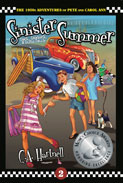
 |
American identity is rife with lore and legend, maverick-minded pilgrims who settled the land and befriended Native Americans, cowboys who blazed trails across the American frontier, and hot-rodding greasers who frightened and electrified sleepy American communities with drag races, diner-dominance, and jelly-rolled hairdos. It is an America of burgers and fries, long sunny days, and a community-centric lifestyle bolstered by biblical references and family values.
These latter sets of icons are central players in this sequel about southern California in the 1950s. Eleven-year-old narrator Carol Ann and her pal Pete are back in this story, enjoying their summer of 1955, even as they become alert to the dangers presented by life, circumstances, bad players, and bad choices. During their typically idyllic July summer vacation, they face older boys with cars who give them a rough time as well as a series of mishaps and accidents.
The world portrayed here fills the senses with symbols of 1950s California life. A time-capsule-like soundtrack always plays in the background, with hits of the day filling the summer air. Movie and television references likewise abound as the kids watch a heroic Errol Flynn film or favorite game shows of the day. Cars are described with artistic flair as is home decor with such time-stamped distinctions as brightly-colored, Formica-topped kitchen tables and matching vinyl chairs.
1950s Los Angeles is a starring character here, as well, with careful attention given to providing a tour of the city as seen through 11-year-old eyes. Through Carol Ann, the city is a tapestry of sights and sounds, including the large hospital where her relatives practice medicine, the famed Tommy’s burger joint, the La Brea Tar Pits, the long stretching boulevards of the San Fernando Valley and the Sunset Strip, the Hollywood sign, and much more eye candy from a quieter and more homogenous Los Angeles of the recent past.
Then, of course, there are the hot-rodders. In this era before video games, did such greasy-haired, engine-revving road hogs exist? According to Carol Ann, they are indeed a real part of the mid-20th-century experience, playing chicken, racing and raising heck, and bullying their way through summer days. These older brothers and neighborhood boys may seem provincial through modern eyes, but to an 11-year-old watching the action more than half a century ago, the threat and fascination were all too real.
Indeed, throughout her story, Carol Ann is conscious of both the joys and sinister components of her summer. This coming-of-age awareness that life offers risk along with fun is universal and well-framed here—so much so that young readers of any generation can enjoy the historic picture while appreciating the dawning realization that life offers its share of danger and consequences.
Still, in Carol Ann’s sinister summer, there are essential comforts as well. Breakfast stacks of fresh pancakes and homegrown peaches with whipped cream start any day off right, as does the backdrop of a loving family and a safe neighborhood. Supporting it all is Carol Ann’s Bible and her already firm grasp of scripture as a source of comfort and explanation. She seeks and tracks biblical verses about trusting God and finding peace. Life may be dangerous, and the children’s world may expand outside the safety of home, but the Bible grows with them, and it soothes even the most sinister of external influences.